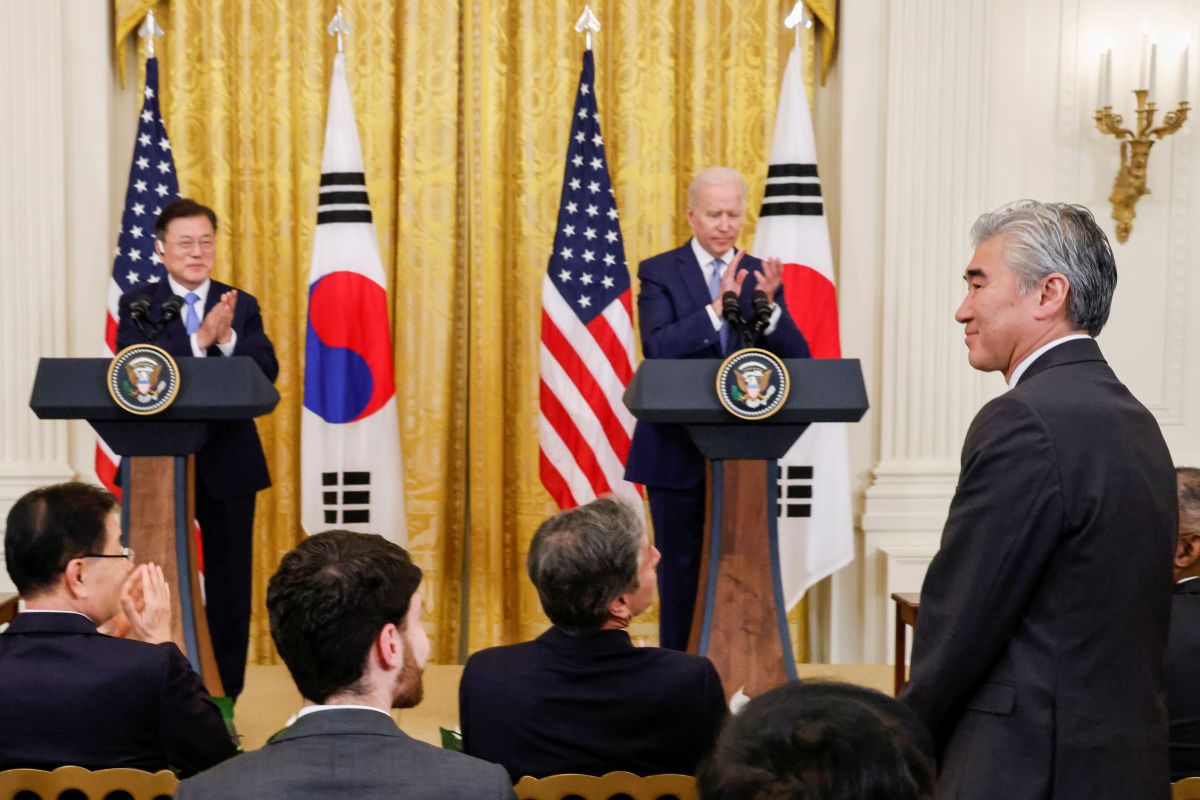The Biden Administration's Vision of North Korea Policy
The main goal of U.S. policy towards North Korea remains the complete denuclearisation of the Korean Peninsula. The Biden administration intends to implement it by continued sanctions pressure, direct negotiations with North Korea, and coordination of actions with allies and other countries. The flexibility of the U.S. approach suggests its readiness to initiate talks aimed at freezing and limiting the North Korean nuclear programme. However, the vague nature of the American declarations and the expectant attitude towards North Korea pose the risk of maintaining the deadlock in the U.S.-North Korea talks and the further development of the North Korean nuclear and missile potential.
 Photo: Jonathan Ernst/Reuters
Photo: Jonathan Ernst/Reuters
Under President Donald Trump, U.S. policy towards North Korea was initially based on “maximum pressure” through economic sanctions and threats to use military force. Then Trump opened up to a dialogue with North Korea, which resulted in his meetings with Kim Jong Un in Singapore in June 2018 and Hanoi in February 2019. After the failure of the second summit, resulting from the stiffening of negotiating positions, a deadlock in the North Korea-U.S. dialogue persists and the North Korean nuclear and missile programmes continue to develop.
At the turn of April to May this year, the Biden administration outlined its approach to North Korea after several months of work on a policy review, taking into account the interim strategic national security guidelines and consultations with allies: South Korea and Japan. The results were presented in the form of short statements by a White House spokeswoman, statements by high officials of the administration (including Secretary of State Antony Blinken and National Security Adviser Jake Sullivan) and information provided by Biden during his summit with President Moon Jae-in of South Korea in May this year.
Assumptions of U.S. Policy Towards North Korea
The declared goal of U.S. policy towards North Korea remains the complete denuclearisation of the Korean Peninsula. Additionally, the Biden administration emphasises the need to increase the security of the U.S., its allies, and American forces in the region. The goals are to be implemented within a “calibrated and practical approach” using instruments of pressure and diplomacy. The U.S. intends to maintain nuclear deterrence, sanctions against North Korea, and raise the issue of human rights in the North to a greater extent than the previous administration. The diplomatic tools are to cover primarily negotiations at the working level, conducted especially by Sung Kim, an experienced diplomat, appointed as special envoy for North Korea. Biden points out that the meeting between the leaders of both countries will be possible only when, during preparatory talks, North Korea expresses its readiness to abandon nuclear weapons. The U.S. intends to build on the experience of the previous administration—negotiations with North Korea are to be conducted on the basis of the statement from the Kim-Trump summit in Singapore. The U.S. also intends to include in its talks with North Korea the provisions of the inter-Korean Panmunjom declaration of April 2018. American policy is to be based on close coordination with its allies South Korea and Japan, as well as consultations with other countries, especially China, the main political and economic partner of North Korea.
Chances and Possibilities
In opting for the denuclearisation of the Korean Peninsula, the administration moved away from its original term “denuclearisation of North Korea”, which narrowed the topic of negotiations down to the North Korean nuclear programme. This may signal that the U.S. is ready to engage in talks with the North on arms control and nuclear risk reduction. Taking into account the failures of previous governments, the Biden administration may be interested primarily in the freezing and gradual reduction of North Korea’s nuclear and missile weapons, assuming that denuclearisation remains the ultimate goal. A sign of the U.S. openness is the offer of talks based on the Singapore statement, the provisions of which, however vague, on the denuclearisation of the Korean Peninsula may constitute an acceptable starting point for North Korea to restart talks. In turn, emphasising the importance of the Panmunjom declaration proves that the Biden administration intends to take into account the inter-Korean context and the perspective of South Korea. Moreover, the frequency of consultations between the U.S., the Republic of Korea, and Japan in the first months of the Biden presidency shows that his administration wants to distinguish itself from the previous one by regular coordination of activities with allies.
Challenges and Limitations
Despite Sung Kim’s readiness to start talks without preconditions, other members of the U.S. administration (including Blinken) make the initiation of negotiations conditional on North Korea’s attitude. So far, the North is not interested in the talks. This may mean that at the present stage the U.S. is not making specific and attractive proposals from a North Korean point of view. The failure of the U.S. to take into account the broader perspective—the offer to ease sanctions and elements of normalisation of relations with North Korea in return for curtailing its nuclear programme—risks repeating the mistakes of Barack Obama’s “strategic patience”. At that time, after attempting a dialogue, the U.S. finally adopted a reactive attitude towards North Korea, limited to exerting sanctions pressure on it. This, in turn, remains ineffective as it does not induce North Korea to make concessions. The cooperation between the U.S. and China will also be a challenge. Given their bilateral tensions, China will not be willing to put pressure on North Korea to persuade it to resume talks with the U.S. Especially since in recent months there has been a political rapprochement between North Korea and China due to the 60th anniversary of the signing of the alliance treaty in July this year, which will be automatically extended for another 20 years.
Conclusions and Perspectives
The Biden administration’s policy towards North Korea is vague, which is both an advantage and a disadvantage: it excludes nothing, giving the U.S. room for manoeuvre, but does not propose specific solutions. Signals from the U.S. administration that it is focusing on reducing threats from North Korea rather than dismantling its nuclear capacity suggest that it is aware of its predecessors’ failures and will take a realistic arms control approach to negotiations. However, the problem may be the lack of sufficient involvement of the U.S., which focuses more on the relations with China, Russia, climate change or internal issues than on North Korea.
If the U.S. wants to limit the development of North Korean nuclear and missile potential, it will be necessary to present both its specific expectations in this regard, such as access to nuclear installations, as well as economic and political incentives, for example, limited easing of sanctions against North Korea. The most difficult part of the negotiations will be determining the details, such as the timing and sequencing of activities that each side should take and their verification. This is already visible at this stage, as neither side is ready to make concessions first to resume talks.
The lack of a specific offer for talks presented to North Korea and the maintenance of a wait-and-see attitude by the U.S. will prolong the deadlock in the talks between both countries. Under these conditions, North Korea will develop its nuclear and missile potential even more, especially at the research level, in line with the declarations of the January Congress of the Workers’ Party of Korea. Although this may be associated with missile tests in the coming months, North Korea is currently focused on the economic situation, which the authorities themselves find difficult, including due to the COVID-19 pandemic. To solve its internal problems and strengthen its negotiating position before possible talks with the U.S., North Korea will tighten ties with China, as it did in 2018. The stalemate in the North Korea-U.S. negotiations will hinder the resumption of the inter-Korean dialogue, requested by Moon Jae-in for his last year in office. Despite the difficulties, South Korea will make further attempts to establish contacts with the North, including offers to supply COVID-19 vaccines due to the delay in deliveries to North Korea under the COVAX initiative.
American declarations on North Korea mean that the U.S. expects other countries, including European allies, to continue to implement sanctions imposed on the North. At the same time, due to the openness of the Biden administration to negotiations, countries maintaining diplomatic relations with North Korea should uphold channels of communication with its representatives to support the diplomatic activities of the U.S. and South Korea by providing good offices. This applies also to Poland, whose diplomats had to leave North Korea due to difficult living conditions caused by pandemic restrictions. It is in Poland’s interest to act to restore the activity of the embassy in North Korea after the lifting of pandemic restrictions in that country.


